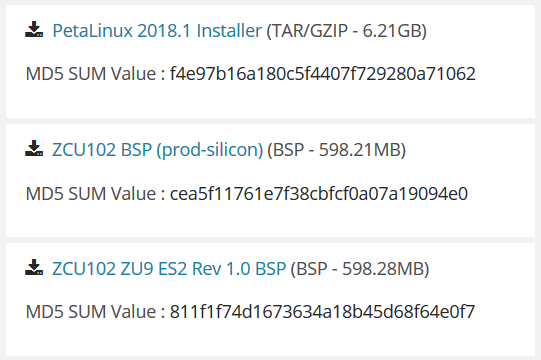 Petalinux user guide.
/settings.sh
(e.g. source /scratch/Xilinx/PetaLinux/settings.sh)
Note: Or use source /settings.csh command for c shell.
Cross check that the PETALINUX environment variable is set to the above installation path
echo $PETALINUX
1.1.1.3.Create the PetaLinux project in a working directory with the below command
(cd /scratch/edt)
petalinux-create -t project –s
(e.g. petalinux-create -t project –s /home/jerrywo/Downloads/xilinx-zcu102-v2018.1-final.bsp)
Change the directory to the created Petalinux project.
(e.g. cd /scratch/edt/xilinx-zcu102-2018.1)
1.1.1.4.Initially configure the PetaLinux project with the corresponding hardware file.
(The file may be copied to /scratch/edt/xilinx-zcu102-2018.1 from your Windows machine C:\zynqus\pwr\sw\pl_lib_wrapper_hw_platform\system.hdf)
petalinux-config --get-hw-description=
(e.g. petalinux-config --get-hw-description=/scratch/edt/xilinx-zcu102-2018.1)
(Nothing is changed by step 1.1.2, this step may be skipped.)
Change directory to /xilinx-zcu102-2018.1 and enter the following command to configure Linux:
(cd /scratch/edt/xilinx-zcu102-2018.1)
petalinux-config
We configure the Memory Location and Serial Port.
1.1.2.1 ‘Subsystem AUTO Hardware Settings->Memory Settings->0x0 System memory base Address’ and
1.1.2.2.‘0x80000000 System memory size'
1.1.2.3 ‘Subsystem AUTO Hardware Settings->Serial Settings->Primary stdin/stdout (psu_uart_0)’
Change directory to /xilinx-zcu102-2018.1 and enter the following command to configure the kernel:
(cd /scratch/edt/xilinx-zcu102-2018.1)
petalinux-config –c kernel
1.1.3.1 ‘Power Management Options > [*] User space wakeup sources interface'
1.1.3.2 ‘Firmware Drivers > Zynq MPSoC Firmware Drivers > [*] Enable Xilinx Zynq MPSoC firmware debug APIs'
(Nothing is changed by step 1.1.4, this step may be skipped.)
Change directory to /xilinx-zcu102-2018.1 and enter the following command to configure the rootfs:
(cd /scratch/edt/xilinx-zcu102-2018.1)
petalinux-config –c rootfs
Change directory to /xilinx-zcu102-2018.1/project-spec/meta-user/recipes-bsp/device-tree/files and edit system-user.dtsi:
(cd /scratch/edt/xilinx-zcu102-2018.1/project-spec/meta-user/recipes-bsp/device-tree/files)
We modify the Device Tree to free up UART1 for RPU use (otherwise RPU can hang waiting for UART).
1.1.5.1 Append the following uart1 configuration:
&uart1
{
status = "disabled";
};
1.1.6 Building the kernel and device tree blob
Change directory to /xilinx-zcu102-2018.1 and enter the following command to build the image.ub and BOOT.BIN under the
images/linux/
folder. These two files are the ones that will be copied to the BOOT partition of the SD card.
(cd /scratch/edt/xilinx-zcu102-2018.1)
petalinux-build
(Note: Ignore the warning "PMU firmware is not built...")
cd /xilinx-zcu102-2018.1/images/linux
(cd /scratch/edt/xilinx-zcu102-2018.1/images/linux)
petalinux-package --boot --fsbl zynqmp_fsbl.elf --u-boot --force
(Note: Ignore the warning "Unable to access the TFTPBOOT folder...")
The steps to run the Linux design from SD Image are as follows:
Petalinux user guide.
/settings.sh
(e.g. source /scratch/Xilinx/PetaLinux/settings.sh)
Note: Or use source /settings.csh command for c shell.
Cross check that the PETALINUX environment variable is set to the above installation path
echo $PETALINUX
1.1.1.3.Create the PetaLinux project in a working directory with the below command
(cd /scratch/edt)
petalinux-create -t project –s
(e.g. petalinux-create -t project –s /home/jerrywo/Downloads/xilinx-zcu102-v2018.1-final.bsp)
Change the directory to the created Petalinux project.
(e.g. cd /scratch/edt/xilinx-zcu102-2018.1)
1.1.1.4.Initially configure the PetaLinux project with the corresponding hardware file.
(The file may be copied to /scratch/edt/xilinx-zcu102-2018.1 from your Windows machine C:\zynqus\pwr\sw\pl_lib_wrapper_hw_platform\system.hdf)
petalinux-config --get-hw-description=
(e.g. petalinux-config --get-hw-description=/scratch/edt/xilinx-zcu102-2018.1)
(Nothing is changed by step 1.1.2, this step may be skipped.)
Change directory to /xilinx-zcu102-2018.1 and enter the following command to configure Linux:
(cd /scratch/edt/xilinx-zcu102-2018.1)
petalinux-config
We configure the Memory Location and Serial Port.
1.1.2.1 ‘Subsystem AUTO Hardware Settings->Memory Settings->0x0 System memory base Address’ and
1.1.2.2.‘0x80000000 System memory size'
1.1.2.3 ‘Subsystem AUTO Hardware Settings->Serial Settings->Primary stdin/stdout (psu_uart_0)’
Change directory to /xilinx-zcu102-2018.1 and enter the following command to configure the kernel:
(cd /scratch/edt/xilinx-zcu102-2018.1)
petalinux-config –c kernel
1.1.3.1 ‘Power Management Options > [*] User space wakeup sources interface'
1.1.3.2 ‘Firmware Drivers > Zynq MPSoC Firmware Drivers > [*] Enable Xilinx Zynq MPSoC firmware debug APIs'
(Nothing is changed by step 1.1.4, this step may be skipped.)
Change directory to /xilinx-zcu102-2018.1 and enter the following command to configure the rootfs:
(cd /scratch/edt/xilinx-zcu102-2018.1)
petalinux-config –c rootfs
Change directory to /xilinx-zcu102-2018.1/project-spec/meta-user/recipes-bsp/device-tree/files and edit system-user.dtsi:
(cd /scratch/edt/xilinx-zcu102-2018.1/project-spec/meta-user/recipes-bsp/device-tree/files)
We modify the Device Tree to free up UART1 for RPU use (otherwise RPU can hang waiting for UART).
1.1.5.1 Append the following uart1 configuration:
&uart1
{
status = "disabled";
};
1.1.6 Building the kernel and device tree blob
Change directory to /xilinx-zcu102-2018.1 and enter the following command to build the image.ub and BOOT.BIN under the
images/linux/
folder. These two files are the ones that will be copied to the BOOT partition of the SD card.
(cd /scratch/edt/xilinx-zcu102-2018.1)
petalinux-build
(Note: Ignore the warning "PMU firmware is not built...")
cd /xilinx-zcu102-2018.1/images/linux
(cd /scratch/edt/xilinx-zcu102-2018.1/images/linux)
petalinux-package --boot --fsbl zynqmp_fsbl.elf --u-boot --force
(Note: Ignore the warning "Unable to access the TFTPBOOT folder...")
The steps to run the Linux design from SD Image are as follows:
-
After Building the Linux Design in 1.1, Copy image.ub and BOOT.bin to a blank (FAT32 format) SD card.
-
Also copy the folder C:\zynqus\pwr\linux\apps to the SD card. It contains Linux demo files.
-
Insert the SD card into the SD Card slot on the ZCU102, set Mode SW6 to Off-Off-Off-On, and power cycle the ZCU102.
 Petalinux user guide.
Petalinux user guide.